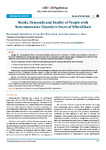Mostrar o rexistro simple do ítem
Needs, demands and reality of people with neuromuscular disorders users of wheelchair
| dc.contributor.author | Pousada, Thais | |
| dc.contributor.author | Pereira-Loureiro, Javier | |
| dc.contributor.author | Díez, Emiliano | |
| dc.contributor.author | Groba, Betania | |
| dc.contributor.author | Nieto-Riveiro, Laura | |
| dc.contributor.author | Pazos, A. | |
| dc.date.accessioned | 2018-03-09T12:16:48Z | |
| dc.date.available | 2018-03-09T12:16:48Z | |
| dc.date.issued | 2017-11-13 | |
| dc.identifier.citation | Pousada T, Pereira J, Díez E, Groba B, Nieto L, Pazos A. Needs, demands and reality of people with neuromuscular disorders users of wheelchair. Examines Phy Med Rehab. 2017;1(1): EPMR.000504 | es_ES |
| dc.identifier.uri | http://hdl.handle.net/2183/20294 | |
| dc.description.abstract | Background: The progressive nature of neuromuscular disease (NMD) results in a reduction in mobility: a person’s ability to move about, or locomotion. Wheelchair is an assistive technology device (AT) that is fundamental to provide a greater degree of independence in mobility to those affected by an NMD, and its use is mediated by factors related to context, activity, and degree of participation. Purpose: To provide an overview of the profile of participants (persons with neuromuscular disorder user of wheelchair) i. To determine the characteristics of wheelchair used by participants ii. To determine the impact of wheelchair in life of people with NMD. Methodology: Cross-sectional study, with a transversal design was employed. Sample was formed by 36 men and 24 women with Neuromuscular Disease (NMD), user of wheelchair, and their caregiver. To obtain information about activities, participation and contextual factors, an original questionnaire was employed, and to evaluate the impact of wheelchair the Psychosocial Impact of Assistive Devices Scale (PIADS) was applied. Results: The results show that, in general, psychosocial impact associated to wheelchair use is positive, with the type of wheelchair, correct matching between AT-person and mobility independence as the main determinants. Conclusion: Knowledge of how the wheelchair is incorporated into a user’s daily life will help him/her to reach his/her objectives and expectations, and to establish the social and personal benefits derived from its use. Independence in personal mobility is the main factor determining a positive impact on the quality of life associated with wheelchair use. | es_ES |
| dc.language.iso | eng | es_ES |
| dc.publisher | Crimson | es_ES |
| dc.relation.uri | http://crimsonpublishers.com/epmr/fulltext/EPMR.000504.php | es_ES |
| dc.rights.uri | http://creativecommons.org/licenses/by-nc-nd/3.0/es/ | * |
| dc.subject | Neuromuscular disorders | es_ES |
| dc.subject | Occupational therapy | es_ES |
| dc.subject | Wheelchair | es_ES |
| dc.subject | Independency | es_ES |
| dc.title | Needs, demands and reality of people with neuromuscular disorders users of wheelchair | es_ES |
| dc.type | info:eu-repo/semantics/article | es_ES |
| dc.rights.access | info:eu-repo/semantics/openAccess | es_ES |
| UDC.journalTitle | Examines in Physical Medicine & Rehabilitation | es_ES |
| UDC.volume | 1 | es_ES |
| UDC.issue | 1 | es_ES |
Ficheiros no ítem
Este ítem aparece na(s) seguinte(s) colección(s)
-
GI-RNASA - Artigos [193]






